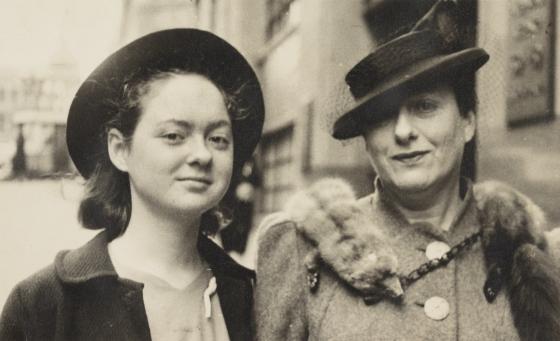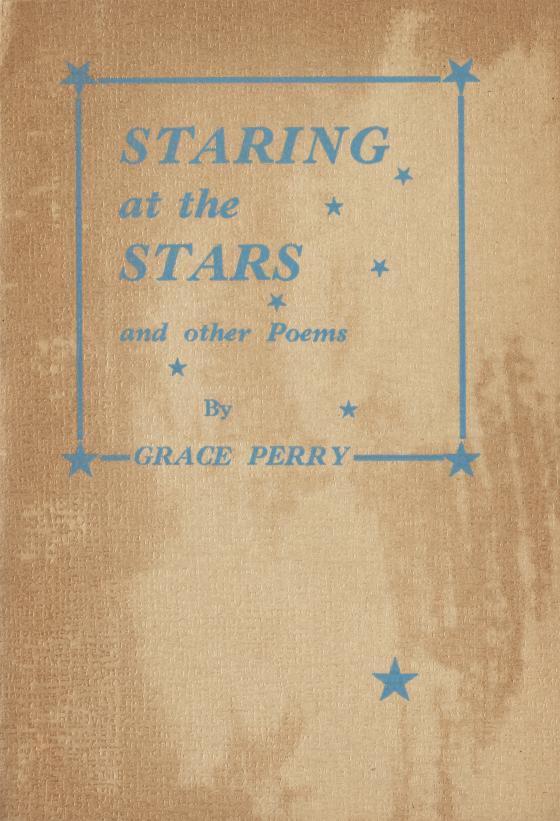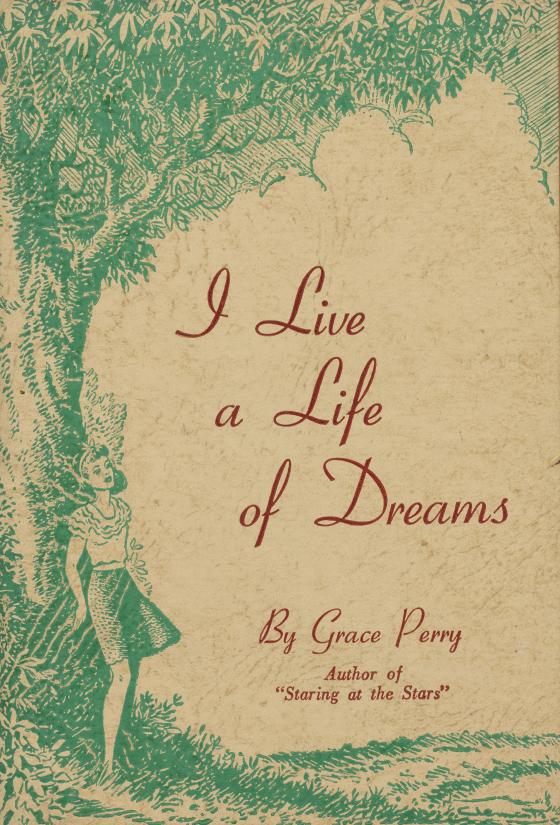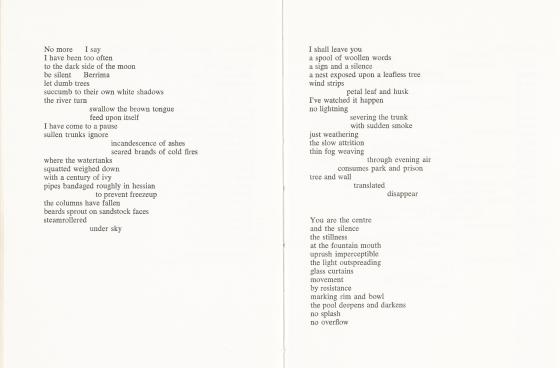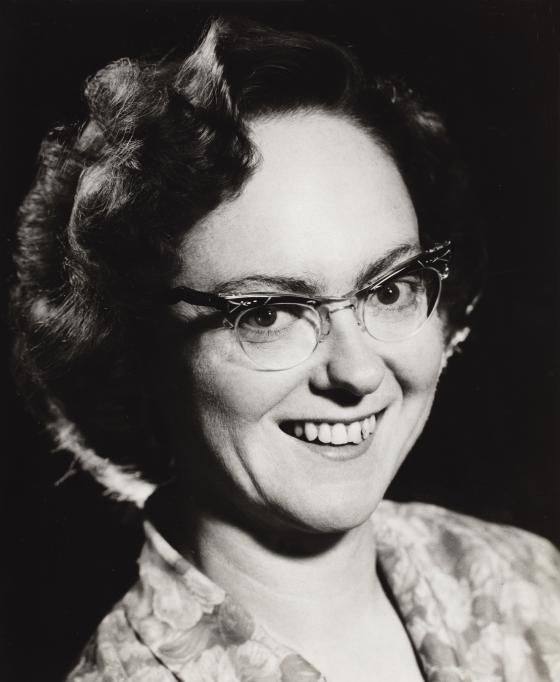In the middle of the Second World War, Australian critics raved about a schoolgirl poet’s ‘pure lyrical note’. One reviewer forecast a career as outstanding in poetry as Melba’s had been in music. ‘A genius,’ said another.
As an adult she became a medical doctor, published a further eight books of poetry, took part in theatrical readings, organised literary festivals, founded a highly regarded small press and edited a magazine.
Who was this marvel of talent and energy?
If you said Grace Perry, take a bow. But if you hadn’t heard of her, it’s not surprising. Despite her multiple roles in twentieth century Australian literature, she is seldom acknowledged these days. Her strong, distinctive poems appear in few anthologies.
Her story is all but forgotten. And what a story it is.
Grace Perry was 15 in 1942 when Australian Consolidated Press published her first booklet of verse, Staring at the Stars. Two more volumes followed: I Live a Life of Dreams in 1943 and I Am the Songs You Sing in 1944. She read her poems on ABC radio and was interviewed on other Sydney stations.
In a 2003 conversation with the poet John Tranter, fellow poet Bruce Beaver recalled how he and Grace met:
I was working at radio station 2UE. I went down the hall one day and I looked through at the announcer and I saw a young girl sitting with him, giving an interview and talking about her plans for the future. I thought, so you want to be a poet. I was just on the verge of starting to write poetry myself. I didn’t start until I was 17. Anyway, I met her and I said, ‘How nice to meet you; you started when you were twelve, did you?’ ‘Oh yes,’ she said, and we talked.
Interviewers were delighted with the young poet’s eloquence and outgoing personality. ‘Her straw school hat pushed on the back of her auburn curls and slightly breathless from hurrying,’ wrote the Sun’s ‘Spotlight’ columnist, Candide, ‘schoolgirl poet Grace Perry arrived to see me during her lunch-hour one day this week.’ While Grace was excited at the prospect of reading her poetry for a national broadcast she had no intention of making a career of it. ‘[T]he idea of a poet living in a garret is out of fashion nowadays,’ she told Candide. ‘I shall continue to write of course, but I hope to become a doctor.’ Grace spent her days ‘like most schoolgirls, at lessons, sport and hobbies, but at night, in her spare time, she writes and practices for her music examinations’.
Born in 1927, Grace started school in Brisbane, where her journalist father, Robert, worked on the Courier-Mail. The family moved to Sydney when Robert Perry became secretary to Mr J Cahill, the Minister for Public Works who later became Premier. Grace was dux of St Gabriel’s, Waverley, an Anglican school that closed in 1966.
After graduating in medicine in 1951, she married fellow medical graduate Harry Kronenberg and had two daughters and a son. Grace ran a home- based medical practice at Five Dock, and later worked as an honorary paediatrician at South Sydney Women’s Hospital, while Harry became a leading haematologist.
Motherhood and medicine left little time for poetry in the 1950s, but by the early 1960s Grace had become a key member of the Poetry Society of Australia, and editor of Poetry Magazine. In 1964 she secured funding from the French Consulate for a bilingual issue of the magazine. Fragile egos abound in the arts, and some poets resented space being given to non-members, or to other languages. In a secret meeting of the society, she was expelled.
Grace held onto one valuable asset: the mailing list. Under her own masthead South Head Press, she founded the magazine Poetry Australia.
Grace Perry’s mature poetry was far less romantic than the rhyming verses of her teens. The lyricism of ‘Heavy fragrance of the flowers,/ Distant: bells from high church towers’ gave way to expressionist free verse which often dealt with sex, illness and death.
Her medical experience can be seen in poems such as ‘The Sting of Sleep’, which concludes:
Find your fulfilment here;
this gentle needle
arrests the ache
and calms the rattling breath;
heading to ocean now,
purple sails fill
and belly out
before the tradewinds of death.
Some admirers of her teenage work were startled by her 1960s collections Red Scarf and Frozen Section, but her new work was generally well received. In 1967 she described her new writing style to Hazel de Berg in a National Library of Australia oral history interview as ‘in the realm of the deep image’:
The image that arises from the unconscious generates powerful emotions beyond the reach of logic or analysis, you know, a bit like the stone dropped in the big pool. I don’t know whether this is valid, I’m no critic ... but this is the way I see it. The work of mine that pleases me most is the work in which I do deal exclusively in images and some of the poems which please me most are those which have just one expanded or continuing image.
In addition to her medical and editorial work, and her own writing, Grace began organising literary events. She formed relationships with universities, funding bodies, sponsors and writers whose names would ensure a big roll-up at readings and symposiums. Responsible for program design, finance, marketing and publicity, she wrote dozens of funding submissions and scores of letters, and made hundreds of phone calls. With a handful of voluntary helpers, she organised events such as the North Side Literary Festival, the Farmers’ Poetry Prize and the 1975 Poetry Write-in, which was held at Macquarie University.
The Write-In was a notable success, with 200 participants keen to share their work and learn from poets like Peter Porter, Gwen Harwood and Bruce Beaver. Grace contributed to some sessions, but ill health prevented her from attending the final dinner. Her multiple roles were becoming a strain.
‘No need to tell me about your extreme vulnerability,’ the West Australian poet and academic Fay Zwicky wrote to her in September 1975, ‘I spotted that in Perth, and incidentally, marvelled at the number of talented delinquent females this country produces — the young child lives on in so many faces, the assertive little hurt girls everywhere. But what a prodigality of energy too!’
Grace was also an energetic publisher. South Head Press published the first single volume by John Tranter, and five books by Bruce Beaver. One of these, Lauds and Plaints, was described by John Beston in the Sydney Morning Herald in 1974 as ‘probably the most important new book of Australian poetry to appear in the 1970s.’ The prestigious imprint listed Norman Talbot, Rodney Hall, John Millett, Craig Powell and Jennifer Maiden among its authors.
Six volumes of Grace’s own poetry also bore the South Head Press imprint. But, in time, self-publishing would injure her reputation. While the poet and critic Geoff Page found her 1972 volume Black Swans at Berrima ‘more impressive than many other recent collections of shorter poems’ (Canberra Times, 1973), a few years later he thought it was ‘mildly narcissistic’ to include an article on her poems in Poetry Australia (Canberra Times, 1980).
In the late 1960s Grace and her husband bought The Magistrate’s House, a grand stone house in Berrima built in 1840. Today, the house can be booked for overnight or weekend stays, but in the 1970s it was a retreat from the stress of multiple responsibilities that complicated Grace’s life and limited her time for writing.
This conflict between her ‘own activism and the temptation to give her energies and power away to other people’, according to literary academic James Tulip writing in Poetry Australia in 1980, precipitated the move from Sydney to Berrima. According to Tulip, Grace ‘needed to enter a dead world. Berrima, a period piece of Australian colonial architecture dominated by the stone and brick prison ... gave her an Emily Dickinson seclusion in the old magistrate’s house and garden on the banks of the Wingecarribee.’
But Grace Perry was no Emily Dickinson, and literary seclusion was not for her. After buying a valley not far from the town, she began breeding Simmental cattle. For the last decades of her life, the Berrima landscape provided the background for many of her poems, published in collections including Two Houses, Black Swans at Berrima, Berrima Winter and Snow in Summer. Her vivid interior life, her highly visual imagination and her nimble leaps from one thought to another unify her work.
From 1974 to early 1980, Poetry Australia was edited by Les Murray, with Grace as managing editor and proprietor. They called it a ‘locum’ arrangement, which suggests it was intended to be short-term. Resigning in May 1980, Murray wrote, ‘It just seems we can’t get the new joint editing rules to work properly, and I suspect I’m the impediment, with my stiff-necked lone-wolf ways. So I drop out without resentments; the mag was an epoch in my life, and no one ever gave me a bigger compliment of trust than you did.’
At the end of the letter he added: ‘6 1⁄2 years! We grew some poets in that time, didn’t we?’
After Murray’s resignation, John Millett was Grace’s co-editor. A poet and former airman, he also shared her interest in cattle breeding. He continued to edit the magazine for some years after her death.
Reviewing Grace Perry’s Snow in Summer in 1980 in the Sydney Morning Herald, Thomas Shapcott described it as ‘a major achievement’, ‘a work of great vulnerability and authority’.
Her vulnerability can also be seen in the stream-of-consciousness notes in her diaries held at the State Library of NSW. Barely legible, they bear witness to periods of despair, but there is little on the public record to account for her death by suicide at the age of 60.
‘Perry won a medal at the New South Wales Premier’s literary awards in 1985 and was appointed AM the next year,’ Dorothy M Jensen writes in the Australian Dictionary of Biography. ‘In 1987 she committed herself to publishing ten volumes of Poetry Australia and providing a Bicentennial poetry award. Failing to acquire funding for the award, she was in very poor health and felt abandoned by her supporters ... Survived by her husband and their son and two daughters, she committed suicide on 3 July 1987 at her Berrima home and was buried in the Anglican section of the local cemetery.’
Grace Perry’s work as a literary entrepreneur and publisher made a major contribution to Australian literature in the mid-twentieth century but is seldom acknowledged now. Her poetry, too, is often overlooked.
Two of the poets published by South Head Press, John Tranter and Bruce Beaver, discussed Grace Perry in a conversation recorded in 2003.
‘She was a very independent person, wasn’t she?’ asked Tranter. ‘Utterly independent, yes,’ replied Beaver. ‘You couldn’t cross swords with her unless you were prepared to get wounded. And she was always ready to have a tussle with anybody, and she was argumentative by nature. But I liked her very much because she was a damn good doctor as well and a very talented person.’
Tranter remarked, ‘I wasn’t that impressed with her poetry,’ and Beaver said, ‘She wasn’t a first-class poet, no, she was a second-class ....’
The two went on to note that her work has ‘fallen into neglect’ and ‘fallen into oblivion’.
Categories such as first- and second- class are always subjective and contestable. The Australian ‘poetry wars’ of the mid-twentieth century led to some clannish loyalties. Grace Perry was too old to be considered one of the ‘Generation of ’68’, despite the fact that her mature poetry had much in common with leading-edge American work. Unconscious sexist attitudes, such as finding women strident or argumentative when they express strong opinions, can impinge on literary judgments. But reputations are not set in stone, and future evaluations of Australian writing will inevitably offer different perspectives.
I give Grace the last words, with the closing lines of her 1967 poem ‘Frozen Section’:
Frozen section: on a glass slide
life fragmented, tissue-thin;
long minutes when each man feels
his silent growth, his open wound.
Dark blood spreads slowly down the sheet.
Beyond the window, yellow lights
hold nudging traffic hesitant,
waiting on riverbottom streets,
the moment frozen, magnified;
no one moves; no one speaks.
Novelist Penelope Nelson is the author of many articles, poems, reports and the memoir Penny Dreadful. Her novels include Prophesying Backwards and Beyond Berlin.
This story appears in Openbook Summer 2020.

